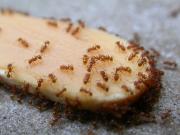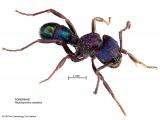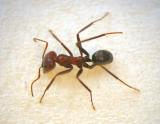Public participation is crucial in protecting Western Australia's agricultural industry, biodiverse environment and our outdoor lifestyle.
Reporting native problematic ants allows for early identification and improved control, due to ant treatment options being dependent on the ant species, and varying for homes, gardens and businesses.
Additionally, identification and proper control of ants not usually found in Western Australia will help to contain and eradicate pest ants, such as the devastating 'tramp' ant species found in other parts of Australia and the world.
Instructions for reporting and sending specimens to the Department's Pest and Disease Information Service (PaDIS) are provided at the end of this page. Once an ant species is identified by PaDIS, advice on treatments and control will be provided.
Impact of ants on agriculture, horticulture, environment and lifestyle
Argentine ants, electric ants and the red imported fire ant are examples of introduced invasive ants that destroy and replace Australian native species of ants and other insects, disrupting or destroying the natural ecological balance.
The aggressive nature of introduced invasive ants impacts on our outdoor lifestyle, cultural activities and ecology. Their aggressive biting, stinging or other attacking behaviour can hurt people and animals, some species even causing lethal anaphylactic shock in some people.
The red imported fire ant poses a serious threat to crops, animals, agricultural machinery, irrigation and electrical equipment. It causes US$1.2 billion damage annually in the state of Texas alone. They kill poultry, lizards, snakes and ground-nesting birds (Vinson, 1994). The Queensland Government predicts southeast Queensland would face a cost of about $43 billion over 30 years if fire ants were left uncontrolled.
DPIRD works with primary industries to safeguard our agricultural resources from biological threats such as introduced invasive ants and to maintain our export opportunities. Agricultural workers can be seriously injured from multiple stings. Farm animals can be blinded by stings to the eyes, or suffocated by swelling after stings to the nostrils.
Introduced invasive ants are a significant horticultural pest because they 'farm' or promote populations of aphids, mealy bugs and scale insects to their own advantage. Introduced invasive ants eat fruit and seed, destroy seedlings and reduce plant pollination by eating or displacing pollinating insects. They also attack beehives.
Introduced invasive ants in Western Australia
Invasive ant species become established widely across the globe by 'hitchhiking' in household goods, plant pots, garbage, sea containers and machinery.
The Argentine ant and coastal brown ant (big-headed ant) are introduced invasive ants which are already established in WA as serious urban pests. The public can help prevent the spread of pest ants by ensuring plant pots sourced from nurseries and friends are free from ants.
There are others such as red imported fire ant, browsing ant and electric ant that threaten WA from interstate and overseas, mainly via ports of entry (air and sea). Introduced invasive ant species currently of greatest concern for Australia and WA are outlined in Table 1 below.
Members of the public who suspect the presence of any invasive ant species should contact PaDIS on (08) 9368 3080 or email padis@dpird.wa.gov.au. Ants listed in Table 1 that have not established in WA are declared pests and under the Biosecurity and Agriculture Management Act 2007 must be reported.
Invasive ant species of concern
| Common name Scientific name | Origin | Western Australian (and legal) status | Australian status | Bites or stings? |
|---|---|---|---|---|
| Solenopsis invicta | Pantanal region of Brazil | WA declared free in October 2023. | Localised incursions (Qld and WA) | Painful sting and stings relentlessly when disturbed (Anaphylactic shock in some people) |
| Lepisiota incisa | Africa | Eradication program ongoing
| Localised incursions (WA) | Bites, but not painful to people |
| Lepisiota frauenfeldi | Southern Europe | Eradication program ongoing | Localised incursions (NT, WA, Qld) | Bites, but not painful to people |
| Electric ant (little fire ant) Wasmannia auropunctata
| Central and South America | Not present Prohibited entry into WA | Localised incursions (Qld) | Painful sting |
| Yellow crazy ants Anoplolepis gracilipes  Yellow crazy ants on bait at Cocos (Keeling) Islands. Image courtesy of Marc Widmer. | South East Asia | Not present Prohibited entry into WA | Localised incursions (Qld, NT, Cocos Island and Christmas Island) | Sprays a formic acid that is painful to eyes |
| Tropical fire ant | Mexico, Central/ South America | Not present Prohibited entry into WA | Localised incursions (NT, Tiwi Islands, Christmas Island, Cocos Island, Ashmore Reef) | Powerful sting (Anaphylactic shock rare but has been reported) |
| Linepithema humile | Argentina and South America | Established in WA | Widely established (WA, SA, Vic, NSW, Tas, ACT) | Bites, but not painful to people |
| (Big-headed ants) Pheidole megacephala | Southern and Northern Africa | Established in WA | Widely established (WA, NT, VIC, Qld, NSW) | Stings, but not painful to people |
| Tetramorium bicarinatum | Africa | Established in WA | Established in WA and other states | Painful sting |
| Trichomyrmex destructor
| North Africa | Established in WA | Established in WA, NT, NSW, QLD, VIC | Painful sting |
Other ant species found in Western Australia
Described below are a number of native and introduced ant species which can be problematic for householders, businesses and farming properties alike. This species list is based on the ant samples submitted to PaDIS for identification. It is not a comprehensive list of all ant species in WA. Click the 'hyperlinked' common name of each ant within the table to access our available ant fact sheets or web pages. Refer also to links on the right hand side of this webpage.
| Common Name Scientific name | Native or introduced | Common locations | Bites or stings? |
|---|---|---|---|
| Ochetellus glaber (native to Australia)  Black house ants
| Native | House-infesting and attracted to sweet liquids and foods | Does not bite or sting |
| Bull ants (Bull dog or inch ants) Myrmecia species | Native | Natural and urban areas. Underground nests | Painful sting |
| Cocktail ants (Valentine ants) Crematogaster species  Cocktail ants (Crematogaster species) | Native | Bush land and residential blocks within bush land | Do not bite but can sting |
| Rhytidoponera metallica | Native | Natural and urban areas. Underground nests | Painful sting |
| Iridomyrmex purpureus | Native | Large mounds in open sunny areas | Bites aggressively with jaws |
| Night or Nocturnal ants (native species only, not Carpenter ants) | Native | Nest in old trees, woodpiles and in the ground | Some species will bite |
 Nylanderia species | Both native and non-native species | Nest in the ground outside. Excavate sand in gardens, lawns and pathways | Harmless and do not sting |
| Iridomyrmex chasei spp. (native to WA) | Native | Nest in the ground, disturb sand in gardens and pathways | Does not sting, but will swarm and bite |
| Technomyrmex species  White footed house ants (Technomyrmex jocosus) with food
| Native and introduced species | Nest in roof and wall spaces, electrical equipment, electrical kitchen appliances etc. |
Does not bite or sting |
Tables 1 and 2 were modified from an Australian Government table.
Reporting and sending specimens for identification
Pest ant identification services are provided to the West Australian public for suspect exotic species and problematic ants. Ants can be easily collected using the sticky side of transparent (clear) sticky tape then gently adhering the tape to white paper. Try not to crush the ants. If the ants are too quick for you to catch on the sticky tape, try using fly spray first. Alternatively, brush ants into a labelled container and seal. Place the ant sample in the freezer for 2 hours.
Detailed instructions for sending a range of insects and plants are available (for WA residents and specimens only) on the sending specimens for identification page.
Enter your contact details on the paper:
- Location where the ants were caught.
- Name and contact details of the collector (telephone number/email address).
- Description of the situation, nests and any damage noticed.
Important: Specimens can be delivered or posted to:
Department of Primary Industries and Regional Development
Pest and Disease Information Service
3 Baron Hay Court
South Perth, WA 6151
CAUTION: DO NOT SEND LIVE ANTS IN THE POST! If you suspect exotic pests (e.g. red imported fire ants) send photographs and descriptions to padis@dpird.wa.gov.au or call (08) 9368 3080 for guidance as this could potentially spread the suspect pest.
Book references
Vinson, S.B., 1994. Impact of the invasion of Solenopsis invicta (Buren) on native food webs. In: Williams, D.F. (Ed.), Exotic Ants: Biology, Impact, and Control of Introduced Species. Westview Press, Boulder, CO, pp. 241-258.














